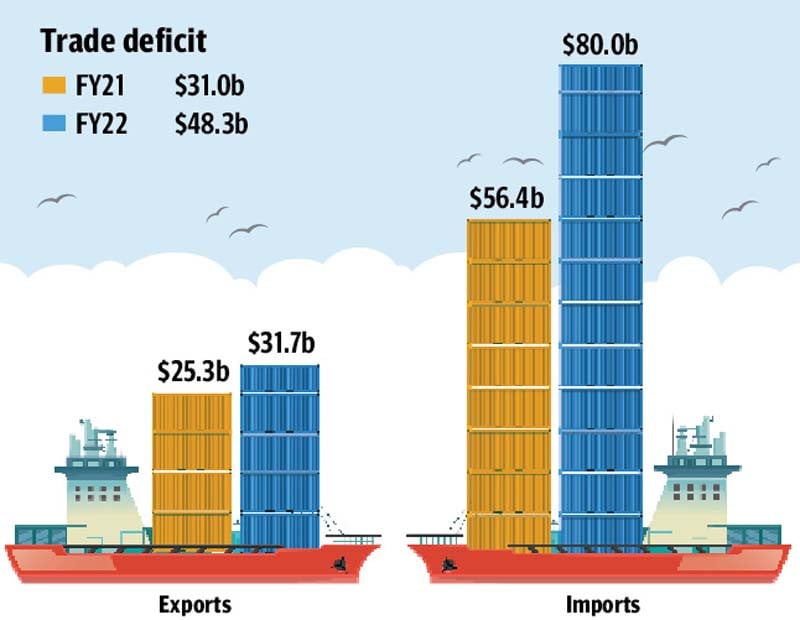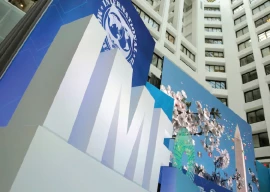
Pakistan’s trade deficit increased at an unsustainable pace of over 55% and skyrocketed to a record $48.3 billion in the just ended fiscal year due to an unmanageable increase in imports that beat all official estimates despite a temporary ban on certain goods.
The international trade results for fiscal year 2021-22 have also made the targets of new fiscal year irrelevant, as the government needs to reduce imports drastically in order to achieve the targets.
Exports surpassed the annual target and stood at $31.7 billion, but the increase was not sufficient to bridge the yawning trade gap, showed the trade summary that the Pakistan Bureau of Statistics (PBS) released on Monday.
Against the target of $55.3 billion, the imports surged to a record $80 billion. The resultant $48.3 billion trade deficit breached the official target by a wide margin of nearly $25 billion.
The national data collecting agency reported that the deficit during the last fiscal year was $17.3 billion, or 55.3%, more than the previous fiscal year. In the preceding fiscal year, the country had booked $31 billion trade deficit.
Although former finance minister Shaukat Tarin took the responsibility of personally monitoring the trend, the imports could not be contained. One reason was the unprecedented surge in global commodity prices.
The previous government had revised upwards the import target to $72 billion, which too proved incorrect.
The higher trade deficit took a heavy toll on the foreign exchange reserves that dropped nearly half from their peak of $20 billion in August last year.
In May this year, the coalition government, led by the PML-N, also imposed a temporary ban on the import of goods, including limits on the quantity of imports. Still, the monthly import bill was recorded at $7.7 billion
in June.
Pakistan imports almost everything – from raw materials to intermediary goods as well as grains and agricultural inputs. A World Bank study showed that the share of intermediary goods in the total imports was 53% while one-fourth imports comprised fuels, leaving virtually no space to contain it.
The country needs to start working on measures that may reverse the existing trend of importing everything – from consumption to manufacturing goods – which has exposed Islamabad to many shocks.
The government’s trade policies have been influenced by a few handpicked exporters, who put pressure to take monetary benefits, keeping the export base narrow and restricted to a few sectors.
It is high time that the government reviewed over Rs100 billion annual subsidies being availed by the exporters, mainly the textile sector.
Exports increased nearly 26% in the last fiscal year and stood at $31.7 billion against $25.3 billion in previous year, according to the PBS.
In absolute terms, there was an increase of $6.4 billion in the exports. The exports were nearly $5 billion higher than the target set by the
last government.
In June, the imports were recorded at $7.72 billion, showing an increase of $1.4 billion, or 22%, compared to the same month a year ago, according to the PBS.
The exports of goods stood at $2.9 billion last month, higher by nearly 6%, or $159 million, over the same month of previous year. Consequently, the trade deficit widened over one-third year-on-year to $4.83 billion in June.
On a month-on-month basis, the exports increased 10% to $2.9 billion in June 2022 over the preceding month, showing a surge of $261 million. Imports showed 14% increase or $945 million over the previous month’s level on a month-on-month basis.
As a result, the trade deficit widened to $4.8 billion in June, up nearly 17%, or $684 million, on a month-on-month basis.
For the new fiscal year 2022-23, the government has set the trade deficit target at just $27.8 billion, which requires a reduction of 42% against last year’s deficit. But the government has not put in place policies that may reduce the trade deficit by $20.5 billion or 42% in one year.
The imports target for the new fiscal year is $65.6 billion, which again seems unrealistic. It will require 22% cut in the import bill in this fiscal year that may not be possible due to higher global commodity prices.
Low trade deficit and imports projections would also make the gross external financing requirements projections unrealistic and lead to faster than expected drawdown of the foreign exchange reserves.
The exports are projected to grow to nearly $38 billion in this fiscal year.
Published in The Express Tribune, July 5th, 2022.
Like Business on Facebook, follow @TribuneBiz on Twitter to stay informed and join in the conversation.

1725523665-0/Minecraft-Movie-(1)1725523665-0-405x300.webp)



1732086766-0/BeFunky-collage-(74)1732086766-0-165x106.webp)

1732084432-0/Untitled-design-(63)1732084432-0-270x192.webp)










COMMENTS (1)
Comments are moderated and generally will be posted if they are on-topic and not abusive.
For more information, please see our Comments FAQ